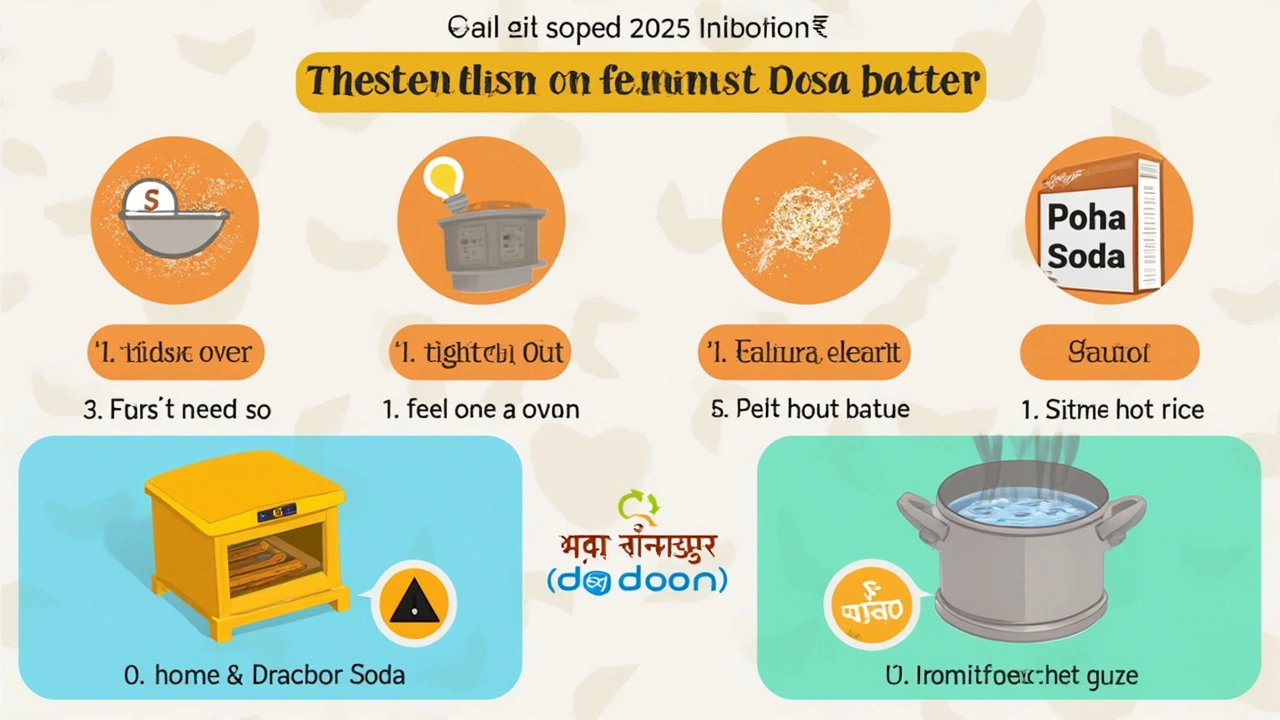Ferment Dosa Batter Immediately: Fast Methods That Actually Work
 Jun, 10 2025
Jun, 10 2025
Waking up with dosa cravings only to find your batter still stubborn and raw is honestly the worst. Luckily, you don't have to wait all night for that tangy, bubbly magic. It’s totally possible to ferment dosa batter almost instantly, if you know the tricks.
Let’s get this straight: classic dosa batter takes 8-12 hours to ferment because those friendly little microbes need time to work. But there are shortcuts. Temperature boosts, handy kitchen hacks, and ingredient swaps can give your batter a serious jump-start—so breakfast or dinner isn’t ruined by dull, flat crepes.
If you live somewhere cold or just want your dosas right now, keep reading. You'll find out exactly what works (and what’s a total waste of effort), plus some common mistakes that make the batter taste weird or not ferment at all. A few tweaks and you’ll have airy, tasty dosas ready faster than you thought possible.
- Why Fermentation Takes Time
- Hacks for Rapid Fermentation
- Smart Ingredient Tweaks
- Troubleshooting Quick Fermentation
Why Fermentation Takes Time
If you’ve ever wondered why your dosa batter fermentation drags on forever, it’s basically because nature works on its own schedule. Fermentation is all about helpful bacteria breaking down starches in the rice and dal, which makes the batter light and brings out that signature tangy flavor.
These bacteria, mostly lactic acid bacteria and some wild yeast, multiply when there’s warmth, moisture, and time. Trouble is, they’re not exactly speed demons. Here’s what slows things down:
- Temperature: The ideal range for bacteria is around 30°C-35°C (86°F-95°F). Cooler kitchens mean slower fermentation. If your place feels chilly or you live in a hill station, the process can take almost twice as long.
- Water Ratio: Too thick or too runny batter? Both slow things down. About 1:3 dal to rice is what most people swear by for quick, even fermentation.
- Type of Rice and Dal: Old rice ferments faster than brand-new rice. Skinned urad dal works better than whole, and you’ll get the best result if you avoid polished versions.
- Salt: Adding salt before fermenting can slow bacteria a bit, but some feel it improves taste. If you’re in a rush, add it after fermentation.
Just to give you an idea, check out these typical fermentation times:
| Batter Location | Room Temperature | Estimator Time (Hours) |
|---|---|---|
| Indian summer (very warm) | 30-35°C | 6-8 |
| South India (mild to cool) | 20-25°C | 10-14 |
| Europe/US winter (cold) | 15-20°C | 18-24 |
So when you wonder why your dosa batter just sits there, think about where you live, the kind of rice and dal you use, and how much warmth you’re providing. It’s not you—it’s science. But if you know where the bottlenecks are, you can totally hack the process. That’s what the next section is all about.
Hacks for Rapid Fermentation
It's not just the classic overnight rest that builds up those bubbles in your dosa batter. There are a bunch of real ways to shortcut the process, and you probably have everything you need in your kitchen.
First up, the easiest trick is using a bit of heat. Warm environments let the natural bacteria do their job quickly. If your kitchen is chilly, stash the bowl inside your oven with just the light on—not the heat, just the light. Most oven lights keep things at a cozy 35°C (95°F), perfect for instant fermentation. You can also leave the batter near a warm cooker or even wrap it in a blanket if things are really cold outside.
Another hack is borrowing from your favorite bakery. A pinch of instant yeast works wonders. For a batch using 2 cups rice and ½ cup dal, a quarter teaspoon of yeast is plenty. Mix it in after grinding and let it sit for 1-2 hours—your batter will puff up almost as well as the traditional style. Don't overdo it, or you'll get a weird yeasty smell.
If yeast isn’t your thing, try a little sugar or jaggery. About ½ teaspoon gives the bacteria more food, making fermentation go 30-40% faster. Don’t worry, your dosas won’t turn out sweet unless you toss in too much.
Still sluggish batter? Try adding a splash of leftover fermented batter (if you have it), some yogurt, or even a tablespoon of poha (flattened rice) before blending. These natural starters are full of active cultures that put fermentation on fast-forward.
- dosa batter fermentation works fastest at around 30-35°C (86-95°F).
- Airtight containers slow things down—cover your batter bowl but don’t clamp it shut.
- Use a big enough bowl: batter can double in size and overflow if you’re not careful.
- Don’t skip the salt—add it after fermenting or your batter may ferment too slowly, especially in colder settings.
| Method | Time to Ferment | Best Use |
|---|---|---|
| Oven Light/Warm Spot | 4-5 hours | Cold climates or winter |
| Instant Yeast | 1-2 hours | Super quick, fluffy dosas |
| Starter (old batter/yogurt) | 3-4 hours | No yeast in the house |
Mess around with these hacks and you’ll see what works best in your home. The more you tweak, the easier it gets to whip up dosa batter fermentation on a whim, even if you’re starting from scratch at dinnertime.

Smart Ingredient Tweaks
Sometimes the secret to instant dosa batter fermentation is right in your kitchen. A couple of ingredient tweaks can flip the script, helping your batter bubble up fast even when the clock is ticking. Here’s what’s proven to work:
- Warm water only: Use lukewarm water (not hot!) when grinding the rice and urad dal. Warmth helps activate natural yeast and good bacteria, so the fermentation jumpstarts sooner. Cold water slows down everything.
- A pinch of sugar: No need to oversweeten. Just half a teaspoon of sugar in your batter acts as fuel for the microbes, leading to quicker fermentation.
- Poha (flattened rice): This classic home hack is gold. Add 2-3 tablespoons of washed poha to your rice and dal before grinding. Poha helps your batter turn soft, fluffy, and rise faster. South Indian grandmas swear by it.
- Fenugreek seeds (methi): Don’t skip it. Add at least half a teaspoon when soaking dal. Fenugreek seeds don’t just boost health—they help make the batter frothy and get things going faster.
- Leftover fermented batter: If you have any old fermented dosa or idli batter hanging around, mix in a couple of tablespoons. This works like a starter culture (just like in sourdough bread) and can save you hours.
Some people try baking soda, but adding it before fermentation often kills the microbes. Use it only if you absolutely need to, and always just before making dosas—not before fermenting.
Here’s a quick look at how these ingredient tweaks compare for speed and effectiveness:
| Ingredient | How Much | Speeds Up Fermentation? | Texture/Flavor Impact |
|---|---|---|---|
| Warm water | As needed | Yes | No change |
| Sugar | 1/2 tsp | Moderate | No noticeable sweetness |
| Poha | 2-3 tbsp | High | Softer, airier dosas |
| Fenugreek seeds | 1/2 tsp | Moderate | Mild, nuttier taste |
| Old fermented batter | 2 tbsp | High | Tangier flavor |
Try at least two of these hacks together for the most reliable results. If you often need quick dosa, keep a bit of old batter in the fridge—it’s your secret weapon. And yep, you can mix and match to see what works best for your taste and your climate.
Troubleshooting Quick Fermentation
Speeding up dosa batter fermentation isn’t always smooth sailing. Sometimes, even with hacks, you end up with batter that’s flat, sour, or just weirdly smelly. Here’s what can go wrong and exactly how to fix it, fast:
- No bubbles or rise: If your batter looks dull and heavy, it probably didn’t ferment enough. This usually means it was too cold or there weren't enough fermenting agents. Place the batter in your warmest kitchen spot—on top of a preheated (and turned off) oven, or near a gas stove if you just finished cooking. If you added a shortcut like yeast or baking soda and still got nothing, check their expiry date!
- Too sour, too fast: Adding yogurt or too much fenugreek can push fermentation overboard, making the batter overly tangy or even watery. Scale back the yogurt next time. For now, mix in a little rice flour to balance the flavor and texture.
- Smells odd or off: A little tang is good, but a rotten smell is a red flag. This usually means it was kept too warm for too long, or contaminated by dirty containers. Toss it—no dosa is worth risking a stomach ache. Always work with clean hands and utensils.
- Batter is too thick or thin: Quick fermentation sometimes messes with texture. If your batter is too runny, stir in rice flour little by little until you get the classic pourable consistency. If it’s too thick, add a splash of water.
Here’s a quick reference for what works and what doesn’t when troubleshooting:
| Problem | Likely Cause | Quick Fix |
|---|---|---|
| No bubbles | Cold environment, weak starter | Move to warmer spot, add pinch of yeast |
| Too sour | Too much yogurt/ferment starter | Add extra rice flour |
| Off smell | Over-fermented, dirty utensils | Discard and start over |
| Wrong texture | Ingredient ratios off | Adjust with rice flour or water |
One sneaky trick: If the batter just won’t wake up, a tiny pinch of sugar can help jumpstart the process, feeding the natural microbes. But don’t overdo it, or you’ll get a sweet dosa! And if you’re working in winter, wrapping the batter in a thick towel or sticking it inside a switched-off oven with the light on can give a cozy warm boost.